Sucking blood isn’t an easy life, even for vampires
Real vampires go well beyond bats to insects and even birds
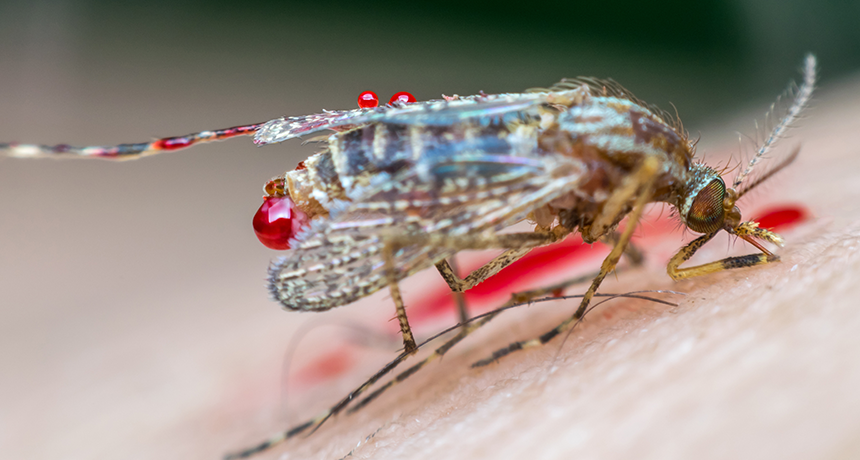
The blood-sucking lifestyle of a mosquito is a hard one for many reasons, including getting smacked to death by a victim.
PongMoji/iStockphoto
By Susan Milius
Jennifer Zaspel can’t explain why she stuck her thumb in the vial with the moth. It was just some after-dark, out-in-the-woods zing of curiosity.
She had been catching moths in the Russian Far East. On this July night, she had just eased a Calyptra into a plastic collecting vial. Its brownish forewings looked like a dried leaf. Of the 17 or so largely tropical Calyptra species, eight were known vampires. Males tend to dine on fruit. But on occasion they will drive their hardened, fruit-piercing mouthparts into mammals and sip some fresh blood. They feed off animals such as cattle, tapirs and elephants — even humans.
Zaspel, however, thought she was outside the territory where she might find a vampire species. She had caught C. thalictri. This species ranges from Switzerland and France eastward into Japan. And it’s widely known as a strict fruitarian. (Fruitarian means something only eats fruit.)
Before capping the vial containing this moth, “I just for no good reason stuck my thumb in there to see what it would do,” Zaspel recalls. To her great surprise, “It pierced my thumb and started feeding on me.”
So make that eight-plus Calyptra vampires.
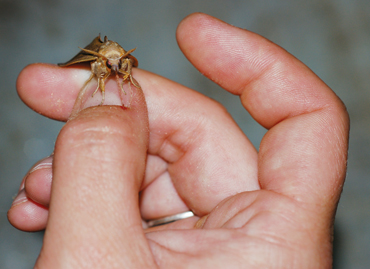
Zaspel is an entomologist now at the Milwaukee Public Museum in Wisconsin. And she still is puzzling over the genetics of the moths at the two Russian field sites she visited in 2006. Males there will bite a researcher’s thumb if offered. But genetic testing so far shows the moths are part of a vast, otherwise mild-mannered species.
Which is just as well. As vampires go, these moths are not stealth biters. “I would compare it to a bee sting,” Zaspel says. For the sake of moth science, one of Zaspel’s colleagues voluntarily tried, despite the pain, to see how long a moth would keep feeding if no one brushed it away. The bite lasted 20 minutes!
Such bites definitely will get noticed. For these moths and other real-life vampires, being smacked to a smear is a bigger danger than getting staked through the heart.
Nabbing the occasional red lunch, or managing to survive on nothing but blood, is far more difficult than it looks in the movies. Relatively few animals manage this lifestyle. And all are indeed remarkable. Vampires include some insects and other arthropods, a few mollusks, some fishes and birds on occasion. Oh, and of course, there are three types of bats.
When dining on blood, there are pressures to gorge as much as possible at each meal. Such heroic volumes, however, can be outright toxic. At the same time, a blood meal is not nutritionally well-rounded. Some key nutrients are missing. Surviving this way takes guts as well as other specialized traits.
Modern tools of genetics and molecular biology are revealing what hidden specializations are needed for blood feeding. Science also is helping to make sense of the lifestyles that go to different extremes — even mouth-to-mouth blood donation.
Many of these biological adaptations would never fit among the showy strengths of the immortals of Twilight or True Blood. But the abilities could certainly count as superpowers.

Educators and Parents, Sign Up for The Cheat Sheet
Weekly updates to help you use Science News Explores in the learning environment
Thank you for signing up!
There was a problem signing you up.
Big dinner
To grasp the risks true vampires take, imagine an animal 35 million times your weight. Now bite it hard enough to make it bleed.
And risk making it mad.
“You can easily get killed by the host,” observes Pedro L. Oliveira. This insect molecular physiologist works at the Federal University of Rio de Janeiro in Brazil. The 35 million multiplier describes a 2-milligram (0.00007-ounce) female mosquito attacking a 70-kilogram (150-pound) human. These measurements came from an article Oliveira coauthored on nutritional overload in bloodsuckers. It appeared in the August issue of Trends in Parasitology.
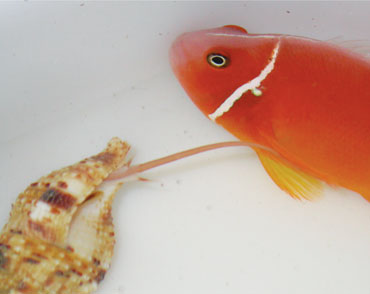
Moreover, finding that giant blood source isn’t easy. “If you go into a forest, you have hundreds of meters separating one vertebrate host from another,” he notes. “Hundreds of meters would be several kilometers [a mile or two] for us.” Then the tiny vampire has to find a capillary — a tiny blood vessel — for biting that is just a few millimeters (about one-tenth of an inch) from the surface of the host’s skin. On a human victim, Oliveira estimates, only about 10 percent of the skin acreage will do.
With so many difficulties and dangers, “most of these guys try to minimize the number of visits,” Oliveira says. They drink fast, and they drink big. A young kissing bug, with its deceptively friendly nickname, can spread the debilitating and possibly fatal Chagas disease. That bug needs only minutes to down about 10 times its weight in blood.
To relate this to human physiology — forget it. There are people who intentionally drink blood (which is another story). But what they down is small in terms of what a real vampire would take away. It would be equivalent to the amount of swallowed blood from a long nosebleed, which can give a human diarrhea, notes Tomas Ganz. He’s a physician at the David Geffen School of Medicine at the University of California, Los Angeles. Fresh blood is difficult for the human gut to process. Plus, too little of the water in blood gets extracted and routed to the kidneys.
With such big blood meals, ingredients that would be harmless or healthful in small amounts now can prove toxic, Oliveira says.
Remove the water in blood. What’s left is almost 90 percent pure protein. Oliveira got an inkling of something perilous in that protein when his lab was exploring the genetics of one of the Americas’ kissing bugs.
This Rhodnius prolixus (ROD-nee-us Pro-LIX-us) has a rounded rear and body that narrows to a skinny little head. The bug lurks in crevices indoors or out. At night both males and females search for humans, their pets or other vertebrates pulsing with a good blood dinner. To be successful, this bug has evolved vampire superstealth. A kissing bug can bite a sleeper without waking that person. The bites of mosquitoes and ticks deliver pathogens in saliva. But a kissing bug delivers the Chagas disease parasite through its excrement. The bug leaves that gift on its host.
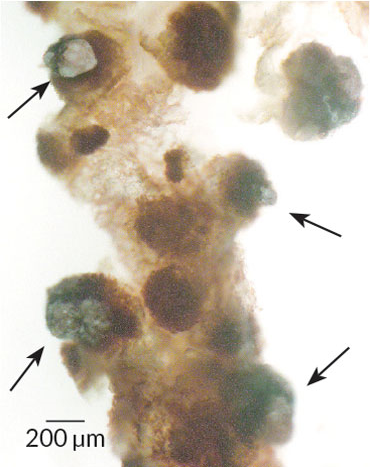
Researchers in 2014 detected many amino acids in that huge drink. The bugs had a massive array of special enzymes available to break down only one of them — tyrosine (TY-roh-seen) — as it washed into the kissing bug gut. Finding those tyrosine-busting enzymes in that gut is “kind of strange,” Oliveira says. In mammals, the liver and kidneys are the only organs with enzymes to break down tyrosine. Then again, most mammals don’t flood their guts with an overwhelming river of protein.
In the lab, researchers messed with the kissing bug to sabotage its breakdown of tyrosine. They either disabled genes or chemically blocked the enzymes. When changed in this way, the bugs died after dining. Oliveira and colleagues reported this last year in Current Biology.
Some of the dead bugs had crystals of tyrosine piercing right through the gut lining. This allowed their gut contents to leak into their body cavity. This discovery, the researchers now propose, might someday give molecular biologists their own drug to serve as a vampire-killing stake.
Blood feeding in insects and other arthropods has evolved multiple separate times (some say 21). But often the vampires have solved the challenge to safely dining on blood in different ways. The challenge of detoxifying tyrosine, however, might be a problem that a lot of critters have solved in unusually similar ways, Oliveira says. That similarity could help pest-fighters, he suspects. Why? Ruining the vampires’ protection against tyrosine might kill different menaces with the same kind of drug, he suspects.
Bad blood
Tyrosine is just one of the nutrients turned toxic by the massive size of blood binges. In the real world, a vampire’s ability to excrete wastes is much more important than some fictional power to hoist trucks.
Jonas Axelsson works at the Karolinska Institute in Stockholm, Sweden. He and his colleagues are studying kidney function in vampire bats. They’re comparing it to kidney health in bat species that live on fruit or nectar.
People typically eat some 50 to 120 grams (1.8 to 4.2 ounces) of protein a day. Eating like a vampire bat, though, would boost a 70-kilogram (150-pound) human’s intake to some 6 kilograms (13 pounds) of protein a day! That protein overdose means these bats have blood concentrations of waste produced by the protein’s breakdown, such as urea, that would be a short route to kidney failure in people.
Yet the vampire bats remain healthy. Their kidneys are only slightly bigger than other that of other bats, Axelsson says. Vampire bats just devote more of their kidneys’ space, he notes, to the long tubules that deal with reabsorbing useful substances from just-made urine.
Much of the protein in blood is hemoglobin. This iron-containing marvel molecule ferries oxygen around the body. This is what helps vertebrates live big and bold. Yet digesting so much hemoglobin in a hurry can free a massive, potentially poisonous dose of iron into the bloodstream.
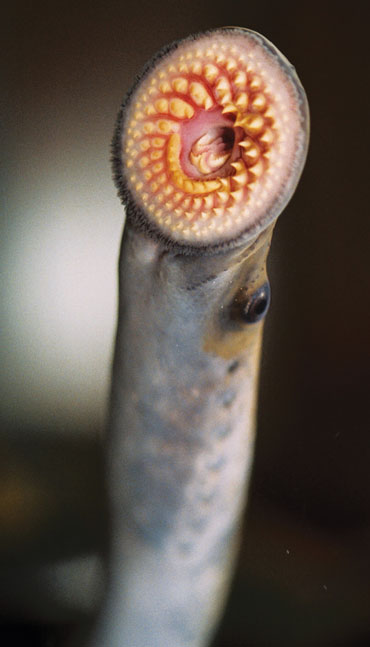
A healthy man makes his doctor happy with iron concentrations in blood of around 127 micrograms (0.000004 ounce) per 100 milliliters (3.4 fluid ounces). Yet concentrations up to 200 times higher don’t seem to harm fishes called lampreys during their larval years. At least, that’s what measurements from various lamprey species suggest. Their young pick up iron while burrowing in the bottom of waterways and eating anything that floats along. When sea lampreys (Petromyzon marinus) mature, they grow jawless toothy gapes. They attach themselves to the side of other fish species and suck their blood. Later, their iron levels in blood drop. Yet even then, they’re still 10 times higher than that of healthy people.
At first, a lamprey sticking to skin feels like “a moistened suction cup on your face,” says Margaret Docker. She’s a lamprey biologist in Canada at the University of Manitoba in Winnipeg. Half of the world’s 38 lamprey species suck blood. She has permitted one exploratory lamprey kiss on her cheekbone. It was from a blood-feeding silver lamprey (Ichthyomyzon unicuspis) found in North American lakes and streams.
Lampreys can generate a good grip. Some even mouth-suck their way up vertical waterfalls or dams. In the very unlikely event of a fish on the face, “the key is to dislodge it … before it starts to rasp in with the teeth on its tongue or oral disk — and before it secretes its anticoagulants,” Docker says. By that, she means blood thinners. A little prying with a fingernail is all it takes to break the suction.
Lampreys may have gone parasitic early in the history of vertebrates. So they have had a long time to evolve their vampiric method. A small fossil from some 360 million years ago, long before dinosaurs arose, shows an oral disk with 14 evenly spaced teeth. The creature already looked very capable of draining blood.
Not enough
Blood may have lethally too much of some things, but lethally too little of others. “Vampires don’t really have it that easy,” muses Rita Rio. She’s a microbial ecologist at West Virginia University in Morgantown.
Blood lacks B vitamins, Rio explains. These are essential nutrients for a wide range of basic bodily chores in animals. Among them: gene regulation, cell signaling and amino-acid breakdown. Animals can’t make their own supplies of these vitamins. Rio’s favorite vampire flies get around this problem with tiny live-in help.
“I have loved tsetse flies ever since I first learned about them,” she says. She’s speaking of sub-Saharan Africa’s Glossina flies. They have a “really cool biology,” she says. Their ability to spread a parasite that gives humans and some other vertebrates a potentially fatal sleeping sickness is more of a turn-off.
Tsetse flies look like robust house flies. They live very differently, however. Insect motherhood is typically low-involvement. Moms usually lay many little eggs and leave them to their luck. But a female tsetse fly has just one offspring at a time. A single egg hatches inside her. And as it grows, it draws sustenance from “milk” glands inside the mother fly. “You’ll see her getting chubbier and chubbier,” Rio says. A mother sometimes gives birth to a youngster that is bigger than she is. The youngster at that point has only its pupal stage to go before it reaches sexual maturity. Explains Rio, “It would be like me giving birth to a 12-year-old.”
Story continues below image.
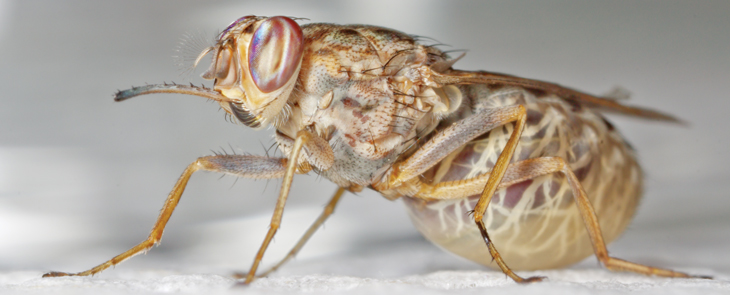
As the mom fly gives her tween a pampered start in life, she also passes along an infection the youngster will need to reproduce on its nutritionally sketchy, all-blood diet. Each larva emerges with its own rod-shaped bacteria called Wigglesworthia. These bacteria flourish inside a special organ inside. There, the microbes churn out B vitamins. The tsetse-fly version of this organ is called a bacteriome. It “looks like a little doughnut around the digestive tract,” Rio says.
Low-fat bats
Another downside of blood is its low fat content, at least from the vampire bat point of view. Fat is a major energy source. So a small, low-fat meal won’t fuel the bat for very long. Yet extra cargo on a small flying mammal is limited to a mere 20 to 30 percent of the animal’s predinner weight. That’s one reason a common vampire bat (Desmodus rotundus) can’t go three days without drinking blood, says Gerald Wilkinson. He’s an evolutionary biologist at the University of Maryland in College Park. The danger of starving so fast may have encouraged the bat habit of blood regurgitation.
This razor-toothed mammal is one of three blood-feeding specialist bats. All are native to the warm latitudes of the Western Hemisphere. The first wild D. rotundus Wilkinson studied were on a ranch in Costa Rica. A bat “would often just fly up and land on the back of a horse,” he says. The bat has a fleshy little nose, “like a pig.” That nose can sense heat. And that’s useful in tracking down where warm blood flows close to the body’s surface.
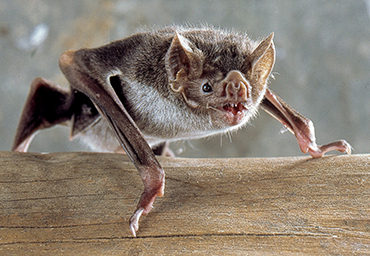
Actually, Wilkinson notes, getting that blood “was a very non-trivial thing” for the bats. They routinely spend half an hour selecting just the right spot on their prey. A bat may clip down horse hair, where needed. Then it will nick out a tiny divot of flesh. Afterward, the bat will lick the wound, often while urinating. And it will do this all without ever waking the horse.
Revisiting a wound on another night appears to be faster than prepping a new site. Wilkinson discovered one night that the bat he was watching on a horse had fed on the same horse, in a different pasture, the night before.
The bat’s saliva has impressive blood-thinning powers, Wilkinson reports. This keeps the blood from clotting. “I’ve been nipped a few times and the blood was hard to stop,” he says. “People who have been fed on will wake up and there’s a pool of blood. And the blood is often from after the bat left.”
Compared with bats of other species, the common vampire bat may even seem to have superpower moves. Instead of just flying, it easily runs across the ground.
When a hungry bat can’t find a meal for a night, the accomplished blood seeker may get a bit of blood from a luckier roost mate. They face each other, mouth to mouth. A well-fed bat sits motionless, he says, as “the other animal is licking.” It’s removing blood that a family member or friend was willing to share, having coughed that blood up into its mouth.
In his early experiments with captive bats, Wilkinson found animals willing to regurgitate on occasion for a hungry bat that’s not a relative. For decades, researchers have debated whether it’s fair to consider this blood donation as examples of natural altruism in vampire bats. This is when an animal does a service for another, at its own expense (meaning it gets nothing obvious in return).
Wilkinson’s former student Gerald Carter works in Germany at the Max Planck Institute for Ornithology in Konstanz. There, he has been studying this potential altruism. He put together unrelated bats from different zoos. He fed them blood collected from a slaughterhouse (not anybody’s favorite part of doing science). He then created short artificial food crises and recorded dozens of instances where one bat donated some blood to another.
Looking at all these examples of sharing, kinship didn’t matter, Carter and Wilkinson conclude. In captivity at least, a vampire will help a starving roost-mate who’s not a relative.
Carter even did a test of how a starving vampire reacts when its main go-to pal for emergency regurgitation “betrays” it by not helping. To simulate betrayal, Carter removed the potential helper from the others. That meant it couldn’t feed its starving roost-mate. On another night, he flipped their roles. The bat that had not helped its pal was now the hungry one in need of that pal’s regurgitated blood.
In general, he found, no hard feelings.
The partner bat who had been forced to deny blood often got fed, later, when it went hungry. The evidence so far looks as if vampires are hedging their bets in sharing blood. That’s what Carter, Wilkinson and Damien Farine of Max Planck proposed in the May Biology Letters. Bats that shared with many partners over the long run end up receiving more blood when they end up in trouble. In an uncertain world, this advantage might favor helping even non-kin. Vampirism may work as a force for generosity.
Way beyond bats
Baby vampire bats go for blood right away. They lick their mothers’ mouths for red regurgitation within minutes of birth. And there are many more vivid variations on vampirism.
There’s blood feeding in a vast dark and dangerous ocean. In some deep-sea ceratioid anglerfishes, males stay miniature. Later, upon finding a female, a male will meld his tissue with her giant body. They thereafter live off her blood system.
There’s also blood feeding by proxy. The jumping spider Evarcha culicivora hunts mosquitoes. It prefers those engorged with human blood. There’s even blood feeding as an impossible dream. Male mosquitoes sip flower nectar. But when scientists served the mosquitoes blood soaked cotton, they ate readily. Given nectar as an alternative, males still preferred the blood, even though it cut short their lives.
And there could be even more vampires out there that science hasn’t yet discovered. All it might take is someone sticking a thumb into a collecting vial.







